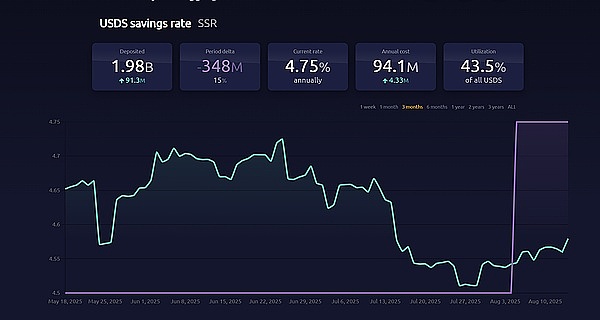Have you seen USDC's 12% annualized current yield on certain platforms recently? This isn't a gimmick. In the past, stablecoin holders were often "interest-free savers," earning zero interest, while issuers invested the deposited funds in safe assets like US Treasury bonds and bills, earning huge returns. This is the case with USDT/Tether and USDC/Circle. Now, however, the dividends that once belonged exclusively to issuers are being redistributed. Beyond the USDC interest subsidy war, a growing number of new-generation yield-generating stablecoin projects are breaking down this "yield wall," allowing holders to directly share in the interest income of the underlying assets. This not only changes the value proposition of stablecoins but also has the potential to become a new growth engine for the RWA and Web3 sectors. 1. What are yield-generating stablecoins?
By definition, a yield-based stablecoin is a stablecoin whose underlying assets can generate income and distribute this income (usually from US Treasury bonds, RWA or on-chain income) directly to the holders. This is significantly different from traditional stablecoins (such as USDT/USDC) because their income belongs to the issuer, and the holders only enjoy the advantage of being anchored to the US dollar, but do not receive interest income. Yield-generating stablecoins, on the other hand, turn holding the coin itself into a passive investment tool. This is achieved by distributing the Treasury bond interest income, which Tether/USDT otherwise accrues, to the wider stablecoin community. An example might make this more intuitive: For example, Tether's issuance of USDT is essentially crypto users "buying" USDT with US dollars. When Tether issues $10 billion in USDT, crypto users deposit $10 billion into Tether in exchange for receiving that $10 billion in USDT. After receiving this $10 billion, Tether doesn't pay interest to users. This is equivalent to receiving tangible US dollars from crypto users at zero cost. If one were to buy US Treasury bonds, this would be zero-cost, risk-free interest income. According to the second quarter forensic report disclosed by Tether, it directly holds more than US$157 billion in US government bonds (including US$105.5 billion in direct holdings and US$21.3 billion in indirect holdings), making it one of the world's largest holders of US Treasury bonds. According to Messari data, as of July 31, 2025, Tether surpassed South Korea to become the 18th largest holder of US Treasury bonds. This means that even with a Treasury yield of around 4%, Tether can still earn around $6 billion annually (roughly $700 million in the first quarter). Tether's operating profit of $4.9 billion in the second quarter further demonstrates the lucrative nature of this model. imToken, based on the market practice that "stablecoins are no longer tools that can be summarized by a single narrative; their use varies depending on individual needs," also divides stablecoins into multiple explorable sub-sets. According to imToken's stablecoin classification method, yield-bearing stablecoins are specifically categorized as providing continuous returns to holders. These primarily fall into two categories: Native interest-bearing stablecoins: Users automatically earn interest simply by holding these stablecoins, similar to bank demand deposits. The token itself is an interest-bearing asset, similar to USDe, USDS, etc.;
Stablecoins that provide an official income mechanism: This type of stablecoin itself does not necessarily generate interest automatically, but its issuer or management agreement provides an official income channel. Users need to perform specific operations, such as depositing it into a designated savings agreement (such as DAI's deposit rate mechanism DSR), staking it, or exchanging it for a specific income certificate before they can start earning interest, similar to DAI, etc.;
If 2020-2024 is the "stablecoin expansion period", then 2025 will be the "stablecoin dividend period". Under the balance between compliance, income and liquidity, income-generating stablecoins may become the next trillion-dollar stablecoin sub-track.

Source: imToken Web (web.token.im)'s income-generating stablecoin
II. Inventory of leading income-generating stablecoin projects
From the perspective of specific implementation paths, most income-generating stablecoins are closely related to the tokenization of U.S. Treasury bonds. The on-chain tokens held by users are essentially anchored to U.S. Treasury assets held by custodian institutions. This not only retains the low-risk attributes and profitability of Treasury bonds, but also has the high liquidity of on-chain assets. It can also be combined with DeFi components to derive financial gameplay such as leverage and lending. In the current market, while established protocols like MakerDAO and Frax Finance continue to increase their investment, new players like Ethena (USDe) and Ondo Finance are also rapidly accelerating their development, forming a diverse landscape ranging from protocol-based to CeDeFi hybrids. Ethena's USDe As the primary driver of this wave of yield-based stablecoins, Ethena's stablecoin, USDe, has recently surpassed the 10 billion supply mark for the first time.
Data from the Ethena Labs official website shows that as of the time of writing, the annualized yield of USDe is still as high as 9.31%, and it had previously maintained at over 30%. The high yield comes mainly from two sources:
ETH's LSD staking income;
funding fee income from Delta hedging positions (i.e., short positions in perpetual futures);
The former is relatively stable, currently fluctuating around 4%, while the latter depends entirely on market sentiment. Therefore, the annualized yield of USDe is also directly dependent on the funding rate (market sentiment) of the entire network to some extent. Source: Ethena Ondo Finance USDY, a leading RWA (Remove Waiver) project, is focused on bringing traditional fixed-income products to the on-chain market. Its USD Yield (USDY) is a tokenized note backed by short-term U.S. Treasury bonds and bank demand deposits. It is essentially a bearer debt instrument, meaning holders can directly hold and receive returns without real-name verification. USDY essentially provides on-chain funds with exposure close to Treasury bond levels while also granting the token composability, allowing it to be integrated with DeFi lending, staking, and other modules to further amplify returns. This design makes USDY a key representative of on-chain money market funds. PayPal's PYUSD: When it launched in 2023, PayPal's PYUSD was primarily positioned as a compliant payment stablecoin, custodianed by Paxos and pegged 1:1 to US dollar deposits and short-term Treasury bonds. Since 2025, PayPal has begun experimenting with adding a revenue sharing mechanism to PYUSD. Specifically, through partnerships with select custodian banks and Treasury bond investment accounts, PayPal has allocated a portion of the underlying interest income (from US Treasury bonds and cash equivalents) back to holders, attempting to bridge the gap between payment and revenue generation. MakerDAO's EDSR/USDS MakerDAO's dominance in the decentralized stablecoin market is self-evident. Its USDS (an upgraded version of the original DAI deposit rate mechanism) allows users to deposit tokens directly into the protocol and automatically earn interest linked to US Treasury yields without incurring additional operational costs. The current savings rate (SSR) is 4.75%, and the deposit volume is approaching 2 billion tokens. Objectively speaking, the name change also reflects MakerDAO's repositioning of its brand and business model: evolving from a DeFi native stablecoin to a RWA revenue distribution platform.

Source: makerburn
Frax Finance's sFRAX
Frax Finance has always been the most active DeFi project in moving closer to the Federal Reserve, including applying for a Federal Reserve master account (allowing it to hold US dollars and trade directly with the Federal Reserve), and launching sFRAX, a collateral vault that uses U.S. Treasury bond revenue. By opening a brokerage account in cooperation with Lead Bank in Kansas City to purchase U.S. Treasury bonds, it can track the Federal Reserve interest rate to maintain relevance. As of the time of publication, the total amount of sFRAX staked has exceeded 60 million, and the current annualized interest rate is approximately 4.8%. Source: Frax Finance Additionally, it's worth noting that not all yield-generating stablecoins can operate stably. For example, the USDM project has announced liquidation, with its minting function permanently disabled, leaving only a limited period of primary market redemption. Overall, the underlying assets of most current yield-generating stablecoins are concentrated in short-term Treasury bonds and Treasury reverse repos, offering interest rates in the 4%-5% range, in line with current US Treasury yields. As more CeFi institutions, compliant custodial platforms, and DeFi protocols enter the market, this asset class is expected to capture an increasingly significant share of the stablecoin market. Third, how do you view the yield premium of stablecoins? As mentioned above, the core reason yield-generating stablecoins can provide sustainable interest returns lies in the robust allocation of their underlying assets. After all, the vast majority of these stablecoins derive their income from low-risk, stable-yield RWA assets, such as US Treasury bonds.
From the perspective of risk structure, the risks of holding U.S. Treasuries are almost the same as those of holding U.S. dollars, but U.S. Treasuries will generate an additional annualized interest rate of 4% or even higher. Therefore, during the high-interest rate cycle of U.S. Treasuries, these agreements obtain income by investing in these assets, and then deduct operating costs and distribute part of the interest to the currency holders, forming a perfect "U.S. Treasury interest-stablecoin promotion" closed loop:
Holders only need to hold stablecoins as certificates to obtain "interest income" from U.S. Treasuries as the underlying financial assets. Currently, the yields of medium- and short-term U.S. Treasury bonds are close to or exceed 4%, so the interest rates of most fixed-income projects supported by U.S. Treasuries are also mostly in the 4%-5% range. Objectively speaking, this "hold and earn interest" model is inherently attractive. Ordinary users can automatically generate interest on their idle funds, while DeFi protocols can use them as high-quality collateral to further develop financial products such as lending, leveraged, and perpetual swaps. Institutional funds can access the blockchain within a compliant and transparent framework, reducing operational and compliance costs. Therefore, yield-generating stablecoins are expected to become one of the most easily understood and readily implemented applications within the RWA space. This is precisely why the current crypto market is rapidly seeing the emergence of RWA fixed-income products and stablecoins based on US Treasuries. From native on-chain protocols to payment giants and upstarts with Wall Street backgrounds, a competitive landscape is already taking shape. Regardless of how US Treasury interest rates evolve in the future, this wave of yield-generating stablecoins, fueled by high interest rate cycles, has shifted the value proposition of stablecoins from "anchoring" to "dividends."
In the future, perhaps when we look back on this time point, we will find that it is not only a watershed in the stablecoin narrative, but also another historical turning point in the integration of encryption and traditional finance.
 Kikyo
Kikyo





